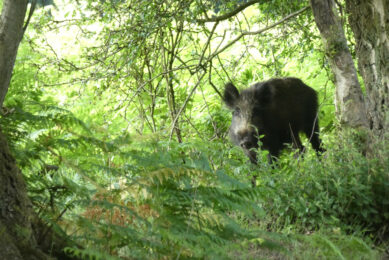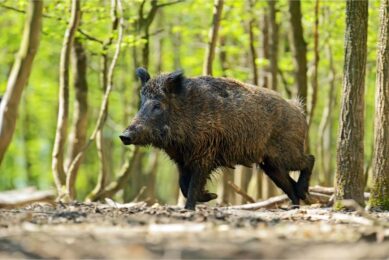Research: Belgian survey on brucellosis in wild boar

Belgian researchers have published a survey on brucellosis in wild boar populations in Belgium, concluding that brucellosis is widespread and increasing. Wild boar could pose a threat to domestic swine.
Background
Brucellosis is frequently reported among wild boar populations in Europe. The aim of the study was to assess the epidemiological situation in Belgium, regarding the steady increase of wild boar populations over the last decades. Several serological tests were used and compared with culture and IS711 polymerase chain reaction (PCR), to determine the most suitable combination of diagnostic tools for conducting a successful prevalence study in wildlife.
Results
An indirect enzyme-linked immunosorbent assay (iELISA) was used on 1168 sera from hunter-killed wild boar sampled between 2003 and 2007 in 4 natural regions of southern Belgium. Results gave an apparent prevalence of 54.88 percent (95 percent CI 52.03-57.73). Prevalence was significantly affected by age and by the year of study, but not by sex nor by the region of sampling. The relative sensitivities of the complement fixation test (CFT), the Rose Bengal test (RBT), and the slow agglutination test (SAT) versus the iELISA differed widely between tests, reaching 62.67, 46.68, and 34.77 percent, respectively.
The relative specificities of the CFT, RBT and SAT versus the iELISA were respectively 99.01, 92.49, and 99.1 percent. From seropositive animals (iELISA), 9 percent were positive by culture and 24 percent by PCR when testing spleen and/or tonsils. Sensitivity of the PCR was higher on tonsils than on spleen. All bacterial isolates were identified as Brucella suis biovar 2.
Conclusions
Brucellosis is widespread among wild boar in southern Belgium, with seroprevalences having increased over 10 years, and constitutes a growing risk of spill back to outdoor-farmed pig herds. The iELISA showed a better sensitivity than the CFT, RBT and SAT. Serological tests must be associated with direct diagnosis and PCR proved more sensitive than culture under wildlife sampling conditions. Spleen and tonsils are lymphoid tissues usually sampled in multi-disease monitoring programs. They remain top-grade organs for direct diagnosis of brucellosis, with a preference for tonsils.
The complete article is available as a provisional PDF. The fully formatted PDF and HTML versions are in production.
About Brucellosis
The most common B. suis biovars (1 and 3) are serious human pathogens and adequate precautions are needed when handling and disposing of potentially infective material.
Brucellosis caused by B. suis biovar 2 differs from infection caused by biovars 1 and 3 in its host range, its distribution, and in its pathology. In general, the geographical distribution of biovar 2 has historically been in a broad range between Scandinavia and the Balkans. The prevalence in wild boars appears to be high throughout continental Europe. In recent outbreaks in Europe, wild boars have been implicated as the source of transmission of biovar 2 to outdoor reared pigs; in rare cases, such as the one recently described in Belgium, other domestic animals, such as bovines, may get infected.
In addition to wild boars, the European hare (Lepus capensis) is also considered as a reservoir for B. suis biovar 2 and has been implicated as a possible source of transmission to domestic livestock.
Brucella suis biovar 2 causes miliary lesions, particularly reproductive tissues, that often become purulent. To date, biovar 2 has rarely been reported as the cause of human brucellosis. However, biovar 2 infection has been reported in two immuno-compromised hunters, who had been extensively exposed through gutting or skinning boars or hares.











